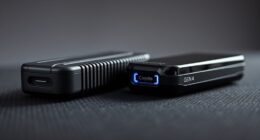ECU flashing for your Lexus LC 500 and RC involves using specialized software like Techstream and a VCI interface to update or reprogram the vehicle’s electronic control units quickly and safely. You’ll need reliable tools, a stable power source, and proper procedures to avoid issues. By ensuring correct steps and troubleshooting, you can enhance performance and features. Keep exploring this guide to learn detailed tips and techniques for a smooth ECU upgrade.
Key Takeaways
- Use Lexus Techstream software with a compatible VCI device for safe, fast ECU flashing via CAN protocol.
- Ensure proper setup: stable power, secure connections, and correct communication protocol before starting the reprogramming process.
- Confirm battery voltage exceeds 12V, and maintain a charger during flashing to prevent interruptions or damage.
- After flashing, clear DTCs and perform health checks to verify successful updates and vehicle functionality.
- Be aware of risks involving third-party tools and always follow OEM procedures to ensure safety and long-term reliability.
Overview of ECU Flashing for Lexus LC 500 and RC
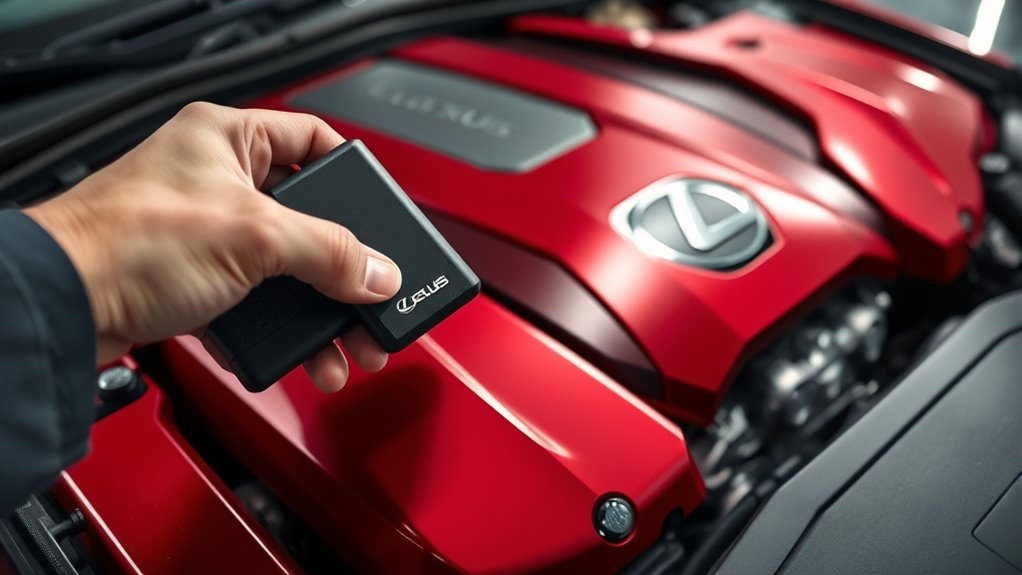
ECU flashing for Lexus LC 500 and RC involves updating or modifying the vehicle’s engine control unit to improve performance, functionality, or features. The process uses specific communication protocols, with CAN protocols offering faster reprogramming times than serial connections. Before starting, you must connect the vehicle to a battery charger and turn off all accessories to prevent interruptions. Proper key cycling is essential; an improper sequence can cause reprogramming failure. The reprogramming time varies from 3 to 30 minutes, depending on the model and protocol used. After flashing, you should clear any Diagnostic Trouble Codes (DTCs) and run a health check to guarantee all updates were successful. This process applies to models from 2019 to 2020, including the LC 500 and RC.
Essential Tools and Equipment Needed
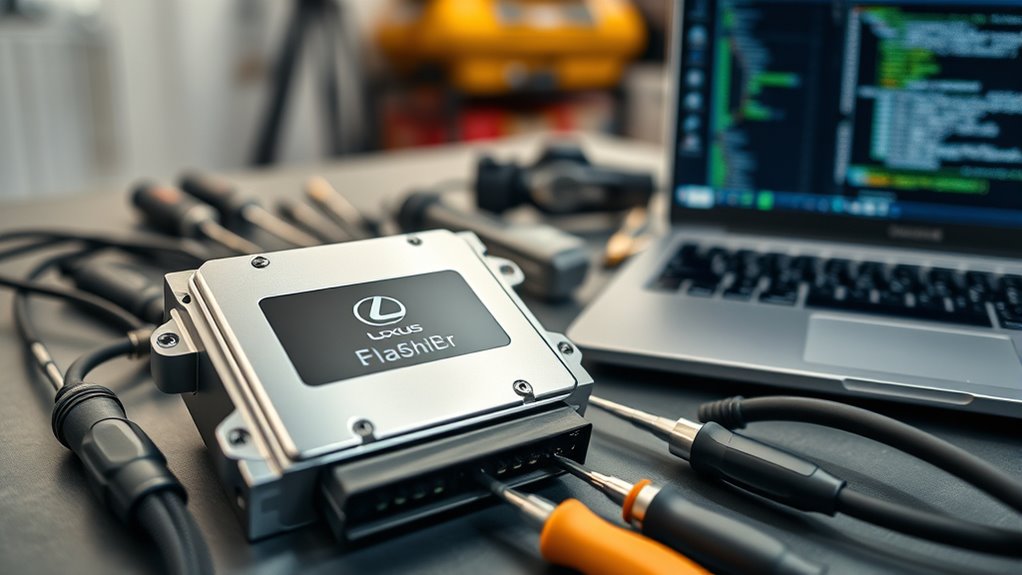
To successfully perform ECU flashing on your Lexus LC 500 or RC, you’ll need a specific set of essential tools and equipment. First, make sure you have Lexus Techstream software, which is crucial for ECU calibration access and reprogramming. A Vehicle Communication Interface (VCI) connects your laptop to the vehicle’s ECU, while a stable internet connection helps download the latest calibration files. You’ll also need a DCA-8000 battery diagnostic tool to maintain a steady voltage of around 13.5V during flashing and prevent interruptions. An OBD-II interface connects to the vehicle’s port, and an ECU-specific adapter may be necessary for certain models. Don’t forget anti-static equipment to protect sensitive components and a reliable power supply mode to avoid voltage fluctuations. Proper workspace safety gear is also recommended for a smooth process. Ensuring that the power supply is consistent is vital to prevent data corruption during flashing. Additionally, understanding the importance of grocery store hours can help plan your shopping around your vehicle maintenance schedule. Maintaining a stable connection is essential for successful ECU reprogramming and avoiding potential errors.
Another important consideration is verifying the support hours for your tools and software to ensure technical assistance is available if needed.
Step-by-Step Process for Successful Reprogramming
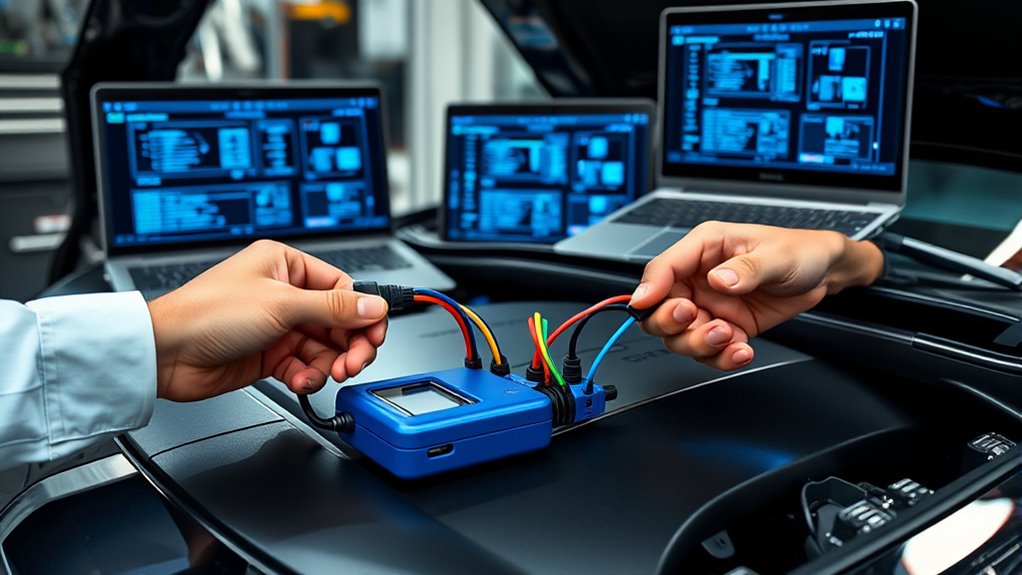
Before starting the reprogramming process, double-check that all preparation steps are complete. Confirm your battery voltage is above 12V and all accessories are off. Open the hood, connect your PC via VIM, and verify communication protocols—CAN reprograms faster. Additionally, ensure you understand Halloween safety tips to prevent accidents during any related activities. It’s also important to select the appropriate airless paint sprayer for your project to ensure optimal results. Recognizing divorce laws can help you better understand your rights during the process. When working with automotive electronics, understanding the effects of eye patch benefits can be useful for post-reprogramming care, especially if sensitive skin is involved. Next, turn the ignition ON (IG ON for hybrids), connect the OBDII port, and confirm compatibility. Decide if you need one or multiple calibration updates, and select the correct communication method.
Customizing Performance: Tuning Options and Benefits
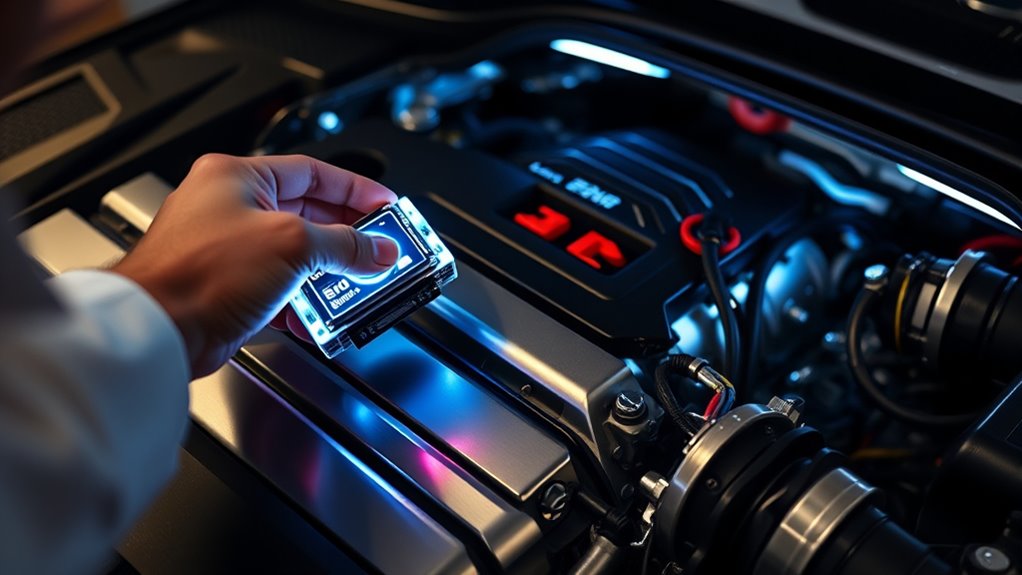
Enhancing your Lexus LC 500 or RC’s performance involves more than just flashing the ECU; it offers a variety of tuning options that can be tailored to your driving style and goals. You can choose from several modifications to maximize power, response, and efficiency:
- Engine Tuning – Adjust fuel injection, ignition timing, and boost pressure for ideal engine output. Proper engine calibration ensures that your vehicle operates at peak performance levels, especially when combined with other modifications. Engine calibration plays a crucial role in achieving optimal results and maintaining reliability. Additionally, understanding how angel numbers relate to personal growth can help you approach your vehicle upgrades with a positive mindset.
- Transmission Tune – Improve gear shifting and response for smoother acceleration. Fine-tuning the transmission can also help maintain reliability under increased power loads.
- Exhaust and Intake Upgrades – Enhance airflow with aftermarket headers and air filters for better performance. Upgrading these components can significantly increase horsepower and improve sound.
- Chassis and Suspension Tuning – Maintain handling balance as power increases, supporting overall driving dynamics. Suspension tuning can also improve ride comfort and stability during spirited driving.
Combining these options lets you customize your vehicle’s behavior, whether for daily driving, track days, or spirited driving experiences. Understanding city dynamics can also help you optimize your vehicle’s settings for different environments and driving conditions.
Ensuring Safety During the Flashing Procedure

Ensuring safety during the ECU flashing process is essential to prevent potential damage and ensure a successful update. Before starting, confirm the vehicle runs smoothly without leaks or unusual sounds. Clear any critical error codes to avoid conflicts. Use a healthy battery or connect a charger, especially for extended flashing sessions. Turn off unnecessary electrical devices like headlights and interior lights to prevent power drain. Check for CAN-bus interference from systems such as alarms. Additionally, verify that your network connection is stable to ensure seamless data transfer during the flashing process. Being aware of local laws and regulations can also help avoid legal complications during vehicle modifications. It is also advisable to familiarize yourself with vehicle electronics to avoid accidental disruptions during the process. Furthermore, understanding Glycolic Acid benefits can be useful if cosmetic skincare is a consideration post-flash. Ensuring proper safety protocols are followed minimizes risks and promotes a smooth flashing experience.
Troubleshooting Common Issues and Error Codes

When troubleshooting ECU flashing issues, identifying the root cause of errors can save time and prevent reprogramming failures. Common errors include low battery voltage, improper key cycling, or communication issues. To resolve these, follow these steps:
- Ensure the battery stays above 12V throughout the process, using a charger if needed.
- Perform proper key cycling—turn ignition on and off correctly to avoid errors.
- Check communication protocols; vehicles using CAN typically reprogram faster (2-7 minutes). Being aware of technological advancements can help adapt troubleshooting methods effectively.
- After flashing, clear Diagnostic Trouble Codes (DTCs) with Techstream and run a Health Check to confirm no persistent issues.
- Be aware that automation in business and other technological advancements can impact the complexity of troubleshooting procedures.
- Recognizing error messages and understanding codes like P0, U, B, or C can help pinpoint specific problems, especially as newer systems incorporate advanced diagnostic tools for more precise fault detection. Staying informed about AI security is increasingly important as vehicle systems become more connected and sophisticated. Additionally, keeping up with software updates ensures compatibility and stability of the ECU flash process. Correct troubleshooting guarantees a successful ECU update.
Specialized Tuning Services for Lexus Models

Specialized tuning services for Lexus models leverage advanced tools and software to optimize performance, reliability, and security. Techstream diagnostic software supports CAN communication protocols, enabling fast reprogramming in 2–7 minutes for factory-sanctioned ECU flashes. Dedicated hardware interfaces like OpenPort 2.0 facilitate custom tuning but lack factory-level diagnostic port flashing in older models. The Andromera Research Automotive Locksmith Kit handles ECU immobilizer reflashing, ensuring security and key programming. TIS (Technical Information System) integration guarantees compliance with OEM calibration standards during dealership updates. While DIY methods exist, such as manual key cycles, they aren’t recommended for newer CAN-based systems. Third-party tuners often use bench-flashing tools to bypass immobilizer locks, offering greater customization but with added risks. It is also important to consider potential security vulnerabilities that may arise when using third-party tuning solutions, emphasizing the need for thorough risk assessment and compliance with industry standards. Additionally, understanding the environmental impact of electronic modifications can help ensure responsible tuning practices. Incorporating industry best practices can further safeguard vehicle functionality and longevity.
Cost Considerations and Choosing the Right Tuning Solution

Choosing the right ECU tuning solution for your Lexus LC 500 or RC depends on your budget and performance goals. You’ll need to evaluate costs, features, compatibility, and long-term value.
Selecting the ideal ECU tune for your Lexus LC 500 or RC hinges on your budget and performance aspirations.
Consider these factors:
- Budget range: Entry-level options start around $300–$700 for basic modules, while high-end supercharger kits with ECU tunes can exceed $6,800.
- Tuning method: OBD2 plug-and-play modules offer quick gains, but standalone ECU flashes provide more refined powerband improvements.
- Compatibility: Hybrids like LS500h aren’t compatible with certain tuners, and emissions compliance may require additional parts.
- Long-term costs: Aggressive tunes may impact reliability and fuel economy, plus supporting upgrades like headers or cooling systems add to total costs.
Matching your goals with these considerations ensures you choose the most effective and cost-efficient solution.
Frequently Asked Questions
Can ECU Flashing Void My Lexus LC 500 or RC Warranty?
You might wonder if ECU flashing will void your warranty. It can, because modifying your vehicle’s computer often voids the powertrain warranty, especially if the dealership sees evidence of tampering. However, laws like the Magnuson-Moss Act limit manufacturers’ ability to void warranties solely due to tuning unless it causes damage. To avoid issues, keep detailed records, be transparent with your dealer, and consider reversing the tune if needed.
How Often Should I Re-Flash or Update My ECU Software?
Imagine your car’s ECU as a finely tuned orchestra, needing just the right updates to stay harmonious. You should re-flash or update your ECU when manufacturers recommend—typically during recalls or TSBs—or every 2-3 years after modifications. Keep an eye on drivability issues or new software releases. Regular checks guarantee your engine runs smoothly, avoiding performance drops and keeping your ride performing at its peak.
Is It Safe to Flash My ECU at Home Without Professional Help?
Flashing your ECU at home isn’t very safe because it requires specialized tools and knowledge. If you don’t do it correctly, you risk damaging your vehicle’s systems, losing data, or causing instability. Since modern vehicles are complex, it’s better to seek professional help. Experts ensure the process is done properly, protecting your warranty and avoiding costly mistakes. Trusting professionals minimizes risks and guarantees the best results.
Will Flashing Affect My Vehicle’S Fuel Efficiency or Emissions?
Flashing your vehicle’s ECU can impact fuel efficiency and emissions. If done correctly, it might improve fuel economy by optimizing engine performance, but improper tuning can increase emissions or cause legal issues, especially with regulations like CARB. Always verify you choose reputable professionals or reliable performance chips. Reversible options are safer, but be aware that unauthorized modifications could void warranties or lead to non-compliance with emission standards.
How Do I Know if the ECU Reprogramming Was Successful?
You might notice a quick coincidence—a check engine light flashes then goes out—indicating a successful reset. Use an OBD-II scanner to confirm no error codes remain, and listen for fuel pump priming or throttle reinitialization at startup. Drive the vehicle to observe smooth shifts and stable idle. If the software version matches the update and live data aligns with factory specs, your reprogramming was successful.
Conclusion
Think of ECU flashing like tuning a fine instrument—you’ll get the best performance when every string is perfectly adjusted. Just like a skilled musician fine-tunes their instrument for harmony, you’ll optimize your Lexus LC 500 or RC’s power and efficiency with care. When done right, it transforms your driving experience from a simple ride to a symphony of performance. So, approach it with patience and precision—your Lexus will thank you.









